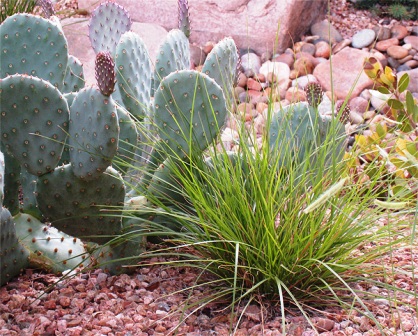Written by David Salman, owner of High Country Gardens
Many years ago when I first became interested in ornamental grasses, I didn’t understand how to use them as a components of a landscape design. Now I use ornamental grasses all the time and have discovered how to combine them in the landscape with other plants. This seems to create a wonderful synergism that accentuates all the attributes of grass and non-grass.
 Sorghastrum (Indian Grass), Panicum (Switch Grass), Bouteloua (Grama), Schizachyrium (Little Bluestem), Andropogon (Big Bluestem), Sporobolus (Sacaton or Dropseed) and Muhlenbergia (Muhly Grass) are genera that contain many of our most showy native ornamental grasses. I’m very gratified to see a building interest in these grasses as they are proving themselves to be some of our most showy, low care, water thrifty native plants.
Sorghastrum (Indian Grass), Panicum (Switch Grass), Bouteloua (Grama), Schizachyrium (Little Bluestem), Andropogon (Big Bluestem), Sporobolus (Sacaton or Dropseed) and Muhlenbergia (Muhly Grass) are genera that contain many of our most showy native ornamental grasses. I’m very gratified to see a building interest in these grasses as they are proving themselves to be some of our most showy, low care, water thrifty native plants.
Some of my favorite species and cultivars of these grasses from this list above include:
‘Llano’ (pronounced ya’ – no) Indian Grass (Sorghastrum)
‘Shenandoah’ and ‘Heavy Metal’ Switch Grasses (Panicum)
Side oats and Blue Grama (Bouteloua)
‘Prairie Blues’ Little Bluestem (Schizachyrium)
Wright’s Giant Sacaton (Sporobolus)
‘Mega Blue’ Big Bluestem (Andropogon)
‘Pink Flamingo’ and Reverchon’s Muhly (Muhlenbergia reverchonii)
When combining cacti, succulents, flowering perennials and woody plants with these ornamental grasses, I like to try and contrast textures, forms and colors to bring out the best attributes of the plants being planted together.
Cacti and Succulents: some of the most interesting characteristics of cacti and succulents are their forms; they are wonderful living sculptures that provide an element of garden art.
Late Season Flowering Perennials: combining late summer and fall blooming perennials and native grasses, provides an opportunity to combine and contrast colors and textures. The wonderful combinations are practically endless.
Native Shrubs: combining low growing, groundcover-like shrubs like ‘Gro Low’ Sumac (Rhus aromatica) with the large growing native grasses like Wright’s Sacaton (Sporobolus wrightii) contrasts form, texture and fall color.
I’ve added few photos that illustrate some of these design ideas;
At the top of the article: ‘Ava’ Hummingbird Mint (Agastache) with Indian Grass (Sporobolus)
Middle of the article: Havard’s Agave (Agave havardiana) with Silky Threadgrass (Nassella tenuissima)
Last photo in article: Beavertail Cactus (Opuntia basilaris v. aurea) with Prairie Dropseed (Sporobolus heterolepis)


